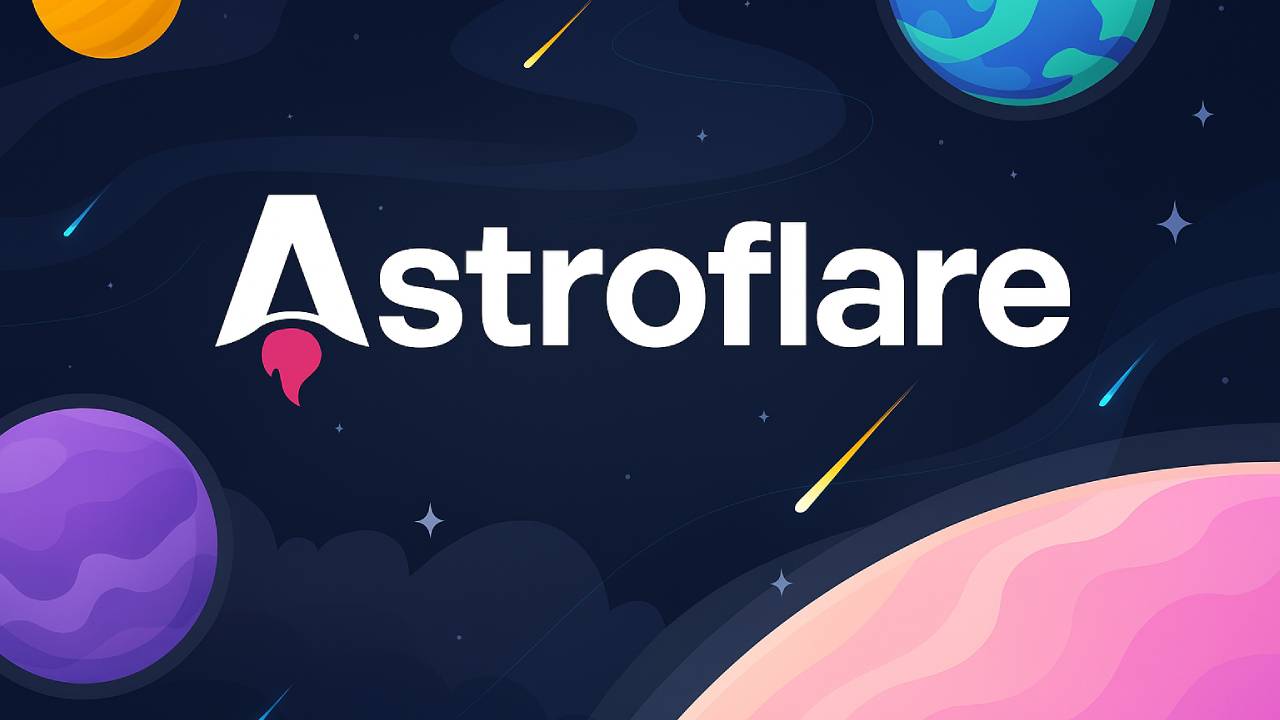

Introducing Astroflare: My Modern Edge-First Starter Template
After spending years working with Rails applications deployed on traditional servers and containers, I’ve been exploring more efficient ways to build and maintain web applications. Today, I’m excited to share Astroflare - my opinionated starter template that combines the speed of Astro with the power of Cloudflare’s edge platform.
Why Astroflare?
Modern web development involves too much maintenance overhead. We spend countless hours upgrading dependencies, patching security vulnerabilities, and managing server infrastructure - time that could be better spent building actual features and solving real problems.
Astroflare addresses this by leveraging two powerful technologies:
-
Astro 5 - A modern web framework that delivers lightning-fast performance by shipping minimal JavaScript and leveraging the power of server-side rendering.
-
Cloudflare’s Edge Platform - A globally distributed network that brings your application closer to users while eliminating traditional server management.
Core Features
The current release of Astroflare includes:
1. Cloudflare D1 Integration
Built-in database support through Cloudflare D1 (SQLite at the edge), with a complete CRUD example implementation for an “items” collection. This demonstrates proper edge database patterns without the complexity of traditional database setups.
2. Edge Functions via Cloudflare Workers
API endpoints built directly into the application with proper TypeScript typing and error handling. This eliminates the traditional API/frontend separation, allowing for a more cohesive development experience.
3. TailwindCSS 4 Integration
The latest version of TailwindCSS for rapid UI development without the bloat of large CSS frameworks or component libraries. This ensures your applications remain lightweight while still looking great.
4. Simple Authentication System
A basic auth system that can be easily extended for more complex authentication needs, demonstrating key security patterns for edge-deployed applications.
5. TypeScript Throughout
Full TypeScript support from frontend to API endpoints, providing type safety and improved developer experience.
6. Comprehensive Testing Examples
Built-in API testing capabilities that make it easy to verify your database connections and CRUD operations are working as expected.
Coming Soon to Astroflare
I’m actively working on enhancing Astroflare with additional features:
1. R2 Storage Integration
Cloudflare R2 offers an S3-compatible object storage solution that works seamlessly with the edge. The upcoming Astroflare release will include:
- File upload/download helpers
- Image optimization pipeline
- Public/private file access controls
- Direct-to-R2 upload patterns for larger files
2. KV for High-Performance Data
Cloudflare KV (Key-Value) store will be integrated for:
- Session management
- Feature flags and configuration
- Cache storage
- Rate limiting implementation
3. Secrets Management
A robust secrets management system is in development that will:
- Automatically sync environment variables to Cloudflare’s secrets
- Validate the presence of required secrets before deployment
- Generate strongly-typed interfaces for your environment variables
- Provide local development configurations that mirror production
4. Email Integration with Resend
Sending emails shouldn’t require standing up an entire email server. The upcoming Resend integration will provide:
- Transactional email templates
- Email verification flows
- Newsletter/notification distribution
- Email analytics and tracking
Database Design for Multi-Tenancy
One of the interesting architectural decisions I’m making with Astroflare is adopting a table-per-user design pattern for multi-tenant applications. Each user gets their own dedicated table in D1, which offers several benefits:
- Complete Data Isolation - No risk of data leakage between users
- Simplified GDPR/Privacy Compliance - Need to delete a user’s data? Drop their table.
- Flexible Schema Evolution - Users can be on different versions of your schema
- Performance Benefits - Smaller tables are faster to query
- Easier Backups and Restores - Export/import individual user data without affecting others
This approach works particularly well for low to medium-scale SaaS applications where data volume per user is manageable, perfectly aligning with D1’s performance characteristics.
Authentication and Payment Plans
While current authentication is basic, I’m designing a comprehensive authentication system that will include:
- OAuth provider integration (Google, GitHub, etc.)
- Magic link authentication
- Two-factor authentication
- Session management
- Role-based access control
For monetization, I’m planning a straightforward payment integration with:
- Subscription management via Stripe
- Usage-based billing options
- Free/paid tier management
- Trial functionality
- Payment reminder emails
Both systems will be modular, allowing you to use what you need for your specific project.
Astroflare Workflow
Astroflare is built to feel seamless across the development lifecycle. Instead of one giant diagram, here’s a breakdown of how it works — from development to production — with each phase shown clearly.
🔁 Development Phase
During development, you work locally with hot reloading, TypeScript, and Astro’s fast refresh loop. You define both frontend components and backend API routes together — no separate repos or stacks.
🚀 Deployment Phase
Push to GitHub, and Cloudflare handles the rest — builds, deploys, and distributes your app globally via Cloudflare Pages and Edge Functions.
🌍 Production Request Flow
Once live, users interact with your app through globally distributed static pages and fast API calls handled at the edge. Data reads/writes go to D1, Cloudflare’s edge-local SQLite.
🔮 Future Features (Planned)
Coming soon: file uploads with R2, session management with KV, and transactional emails with Resend — all handled at the edge for max performance, minimal setup.
How Astroflare Works
Let me walk through a typical user journey in an Astroflare application:
-
Development: You build your application using Astro, TypeScript and TailwindCSS, creating both UI components and edge function API endpoints in the same codebase.
-
Deployment: With a simple
git pushor through CI/CD, your application is deployed to Cloudflare Pages, which distributes it globally across Cloudflare’s edge network. -
User Interaction: When a user visits your application:
- Static content is served instantly from the nearest edge location
- Dynamic content is rendered through Astro’s server-side rendering
- API requests are handled by edge functions running close to the user
- Data is stored/retrieved from D1 databases, also running at the edge
- Files are stored in R2, authentication state in KV, all without dedicated servers
-
Business Operations: In the background, the platform handles:
- User authentication and session management
- Subscription and payment processing
- Email communication for notifications and marketing
- Data isolation through the per-user table design
All of this happens without you having to manage servers, worry about scaling, or deal with traditional infrastructure concerns. The architecture is designed to be:
- Resilient: Distributed across Cloudflare’s global network
- Performant: Running close to users with minimal latency
- Secure: Protected by Cloudflare’s security features
- Cost-effective: Pay only for what you use, with no idle servers
- Maintainable: Simple codebase with minimal dependencies
Why I Built This
After my experience migrating Linkarooie from Rails to Astro, I realized how much simpler the development and maintenance cycle became. No more worrying about server updates, dependency conflicts, or complex deployment procedures.
Astroflare represents this philosophy - focusing on building features rather than maintaining infrastructure. It’s designed for developers who want to move fast, stay secure, and deliver exceptional performance without the traditional overhead.
Get Started with Astroflare
Ready to try it out? Astroflare is available on GitHub.
To get started:
# Clone the repository
git clone https://github.com/loftwah/astroflare.git my-project
# Install dependencies
cd my-project
npm install
# Start the development server
npm run devI’d love to hear your feedback and see what you build with it. Feel free to open issues, submit pull requests, or reach out to me directly.
Here’s to building simpler, faster, and more maintainable web applications!